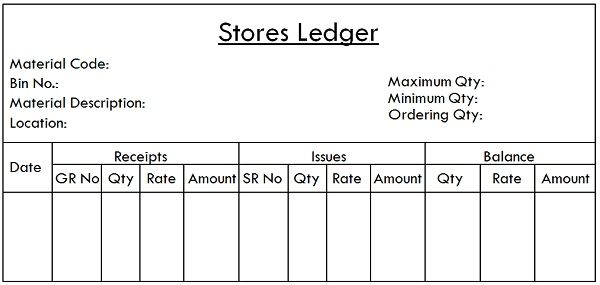 Bin Card implies a document which records the quantity of material received by, issued to and remained in stores. Conversely, Stores Ledger is a ledger account (accounting record), that maintains the record of the transit of goods in and out, the stores, both in quantitative and monetary terms.
Bin Card implies a document which records the quantity of material received by, issued to and remained in stores. Conversely, Stores Ledger is a ledger account (accounting record), that maintains the record of the transit of goods in and out, the stores, both in quantitative and monetary terms.
Perpetual and Periodic Inventory System are two systems that record the movement of stock maintained by the stores department. Perpetual Inventory System keeps a record of every now and then of materials. It comprises of Bin Card and Stores Ledger, to keep track of various items.
Stores ledger is similar to bin card, except that stores ledger contains receipts, issues, and balance of materials in monetary value along with their quantity. Take a read of the article to know difference between bin card and stores ledger.
Content: Bin Card Vs Stores Ledger
Comparison Chart
| Basis for Comparison | Bin Card | Stores Ledger |
|---|---|---|
| Meaning | Bin Card implies a quantity record of the receipts, issue and balance of materials in stores. | Stores ledger alludes to a subsidiary ledger, that keeps track of each and every transaction relating to materials in the stores. |
| What is it? | It is a recording document. | It is an accounting record. |
| Responsibility | Storekeeper | Cost accounting department |
| Location | Kept inside the stock room. | Kept outside the stock room. |
| Details | Contains quantitative details only. | Contains both quantitative and monetary details. |
| Interdepartmental transfer | Are not shown in bin card. | Indicated in stores ledger. |
| Entries | Entries are posted when transaction takes place. | Entries are posted after transaction took place. |
| Recording | Transactions are recorded individually. | Summarized transactions are recorded. |
Definition of Bin Card
In cost accounting, bin card is used to mean a document that keeps a record of the items held in stores. Bin implies a container or space to keep materials, and with each bin, a card is placed, that comprises of details of material received, issued and returned. Moreover, it contains details relating to the number of items, their description and relevant notes (if any).
Bin card is used to quantitatively record the items received, issued and remained in the stores. As and when the transaction takes place, the entry is made in the bin card, after which the materials are taken to/given from stores.
At the time of receiving materials, the quantity is entered in the receipt column of the bin card from material requisition note (MRN), and on the transfer of goods to various departments, the entry is made in issue column of the card.
Definition of Stores Ledger
Stores ledger may be defined as a record maintained by the cost accounting department of the enterprise. It is an assemblage of cards or sheets, which are maintained to keep a record of quantity and cost of material received, transferred and remained in stock. It comprises of an account for each item in the stock room that keeps the record of:
- Quantity
- Type
- Rate
- Amount
Stores Ledger is a subsidiary ledger to the cost ledger (main). It is used to keep track of all receipt and issue transactions concerning materials. And to do so, entries are made in respective columns for various transactions. Recording of additional information for quantity on order and reserved can also be done.
Key Differences Between Bin Card and Stores Ledger
The basic differences between bin card and stores ledger are elaborated below in the following points:
- Bin card can be understood as quantity record of the receipts, issue, and balance of each item in the stock room. In contrast, stores ledger is an accounting record of each and every transaction regarding the materials in the stock room.
- In cost accounting, bin card refers to a recording document, whereas stores ledger indicates an accounting record.
- It is the responsibility of the store keeper to maintain bin card. On the other hand, the enterprise’s cost accounting department maintains stores ledger.
- Bin card is maintained inside the warehouse or stores, but stores ledger is always kept outside the stores.
- Bin card only consist of quantitative details, i.e. only the quantity of material received, issued, returned and those in stock are recorded. Conversely, stores ledger keeps a record of both quantity and cost of material received, issued and at hand.
- Transactions relating to interdepartmental transfers are not recorded in bin card, as they are only entered in stores ledger.
- In Bin Card entries are recorded as and when the transaction occurs, i.e. first the entry is made, and then goods are given from or taken to the stock room. As against this, entries are posted in the stores ledger after the transaction is accomplished.
- In the case of bin card, each transaction is recorded separately, but in stores, ledger transactions are tracked in summarized form.
Proforma
Bin Card
Stores Ledger
Conclusion
Perpetual Inventory System is mainly used by the firms for material control. The effectiveness of this system relies on stores ledger and bin cards, and the quantity balances of these two. There are instances when quantity balances of bin card and stores ledger do not tally, due to various reasons like an arithmetical error, posting in wrong document/sheet, non-posting of a transaction in any of the two, etc.








Kabiru yahaya says
Thanks to you all for this wonderful experience and I hope you are doing well